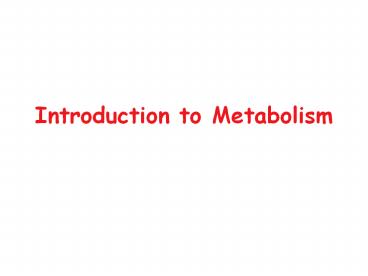Introduction to Metabolism - PowerPoint PPT Presentation
1 / 47
Title:
Introduction to Metabolism
Description:
Introduction to Metabolism Metabolism (The Acquisition and Utilization of Free Energy) Catabolism: exergonic oxidation Anabolism: endergonic processes Anabolism and ... – PowerPoint PPT presentation
Number of Views:37
Avg rating:3.0/5.0
Title: Introduction to Metabolism
1
Introduction to Metabolism
2
Metabolism(The Acquisition and Utilization of
Free Energy)
- Catabolism exergonic oxidation
- Anabolism endergonic processes
3
Anabolism and Catabolism
4
ATP
5
Sources of ATP
- Phototrophs photosynthesis
- Chemotrophs oxidation of organic compounds
6
NADP
7
NADPH
8
Metabolic Pathways
A gt B gt C gt D gt E
9
Potential Futile Cycles
10
Properties of Metabolic Pathways
- Irreversible (overall) reversibility of
individual steps - Separate Anabolic and Catabolic Pathways
- First Committed (Exergonic) Step others close to
equilibrium - Regulation (usually first committed step) often
rat-limiting - Compartmentation transport
11
Regulation of Metabolic Pathways
- Specific Controls
- General Controls
12
Specific Controls
- Control of Enzyme Amount (153B)
- Constitutive Enzymes
- Inducible Enzymes
- Repressible Enzymes
- Control of Enzyme Activity (153A)
- Regulatory Enzymes
- Effectors (Ligands)
13
General Controls(Integration of Cellular or
Organism Functions)
- Internal Effectors
- Catabolite Repression
- Energy Charge
- Reduction Potential
- External Effectors (e.g. hormones)
Significance Efficiency and Flexibility!
14
Energy Charge(Daniel Atkinson)
Steady-State E.C. 0.93
15
Types of Reactions
16
Group Transfer Reactions
17
Phosphoryl Group Transfer
18
Oxidation-Reduction Reactions
SH2 NAD H2O gt S NADH H3O
SH2 Reduced Substrate S Oxidized Product NAD
Electron Acceptor
19
NAD
20
Alcohol Dehydrogenase(Oxidation-Reduction
Reaction)
21
Elimination Reactions
22
Isomerization Reactions(Intramolecular Hydrogen
Shifts)
23
Racemization and Epimerization
- Racemization change stereochemistry of only
chiral center - Epimerization change stereochemistry of one
chiral center of molecule with more than one
chiral centers
24
Rearrangements(altered carbon skeletons)
25
Making C-C Bonds
26
Breaking C-C Bonds
27
Experimental Approachesto Metabolism
28
Features of Metabolic Pathways
A gt B gt C gt D gt E
- Sequences and Energetics
- Enzymes and Mechanisms
- Control Mechanisms (Regulation)
29
Elucidation of Metabolic Pathways
A gt B gt C gt D gt E
Metabolic Inhibitors accumulation of
intermediates Biochemical Genetics
mutants Pathway Labeling isotopes
30
Metabolic Inhibitors(Accumulation of
Intermediates)
- Iodoacetate fructose-1,6-bisphosphate
- Fluoride 3-phosphoglycerate and
2phosphoglycerate
31
Biochemical Genetics(Mutants)
- Natural Genetic Defects
- Manipulation of Microorganisms
A gt B gt C gt D gt E
Accumulation of Intermediates Growth Requirements
(auxotrophic mutants)
32
Pathway Labeling
A gt B gt C
Stable Isotopes Radioisotopes
33
Detection of Isotopes
- Stable Isotopes
- Mass Spectropmetry
- NMR
- Radioisotopes
- Proportional Counting (Geiger Counter)
- Liquid Scintillation Counting
- Autoradiography
34
Enzymes and Mechanisms
- Biochemistry
35
Control Mechanisms (Regulation)
- Molecular Biology
- Biochemistry
36
Compartmentation(Isolated Organs/Tissues, Cells
and Subcellular Organelles)
- Cell Biology
- Biochemistry
37
ATP
Phosphoester Bonds acid and alcohol Phosphoanhydr
ide Bonds two acids
38
Kinetic StabilityofPhosphoanhydride Bonds
39
Coupled Reactions
?Go (kJ/mol)
---------- Fructose-6-P Pi gt
Fructose-1,6-bisP H2O 13.3
ATP H2O gt ADP Pi
-30.5 --------------------------------------------
----------------------------------- Fructose-6-P
ATP gt Fructose-1,6-bisP ADP -17.2
40
Role of ATP
- Early stages of nutrient breakdown
- Glucose ATP gt Glucose-6-P ADP
- Interconverson of nucleoside triphosphtes
- NDP ATP gt NTP ADP
- Nucleoside Diphosphate Kinase
- Physiological processes
- Muscle contraction
- Active transport
41
Role of ATP
- Additional phosphoanhydride cleavages in highly
endergonic reactons - (NMP)n NTP gt (NMP)n1 PPi
- PPi H2O gt 2 Pi
- Pyrophosphatase
42
Formation of ATP
- Substrate-level phosphorylation XP ADP
gt XH ATP - Oxidative phosphorylation
- Photophosphorylation
- Adenylate Kinase reaction 2 ADP gt AMP
ATP
43
Substrate-level Phosphorylation
44
Oxidative Phosphorylation
45
Photophosphorylation
46
Other High-Energy Compounds
47
Steady State































